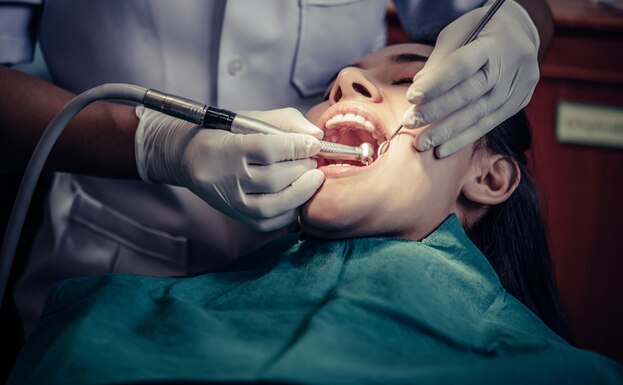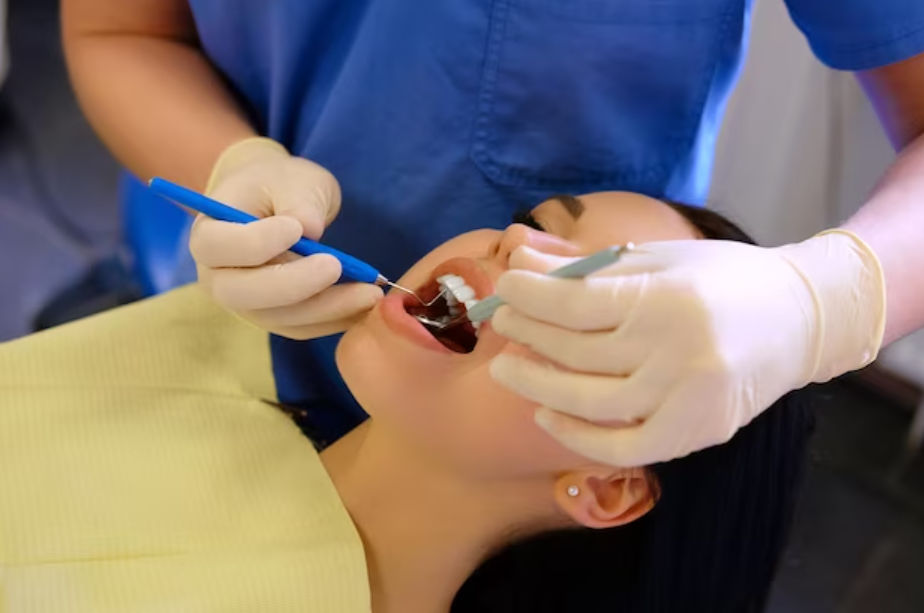Key Takeaways
- Different gum grafts include connective-tissue grafts, free gingival grafts, and pedicle grafts.
- The healing process after gum grafting is crucial for preventing further gum recession and tooth loss.
- Tips for a speedy recovery include rest, applying ice packs, avoiding excessive bleeding, following a soft food diet, and following any specific dietary instructions provided by the dentist.
- After a gum graft, pain and swelling are common, speaking may be challenging, and avoiding touching or playing with the dressing covering the surgical site is essential.
Gum Grafting and Healing are crucial pillars in modern periodontal care, addressing the restoration and regeneration of gum tissues. Compromised gum tissue can lead to various dental concerns, whether due to periodontal disease, injury, or genetic predisposition. Gum grafting is a transformative procedure to repair and augment receding or damaged gums. Understanding the process, its intricacies, and the subsequent healing phases is vital for individuals exploring this corrective dental intervention. You’ll be on your way to a speedy recovery with proper care.
- Understanding and Types of Gum Grafts
- Healing Process After Gum Grafting
- Tips for a Speedy Recovery
- What to Expect After a Gum Graft
- Cost and Complications of Gum Graft Surgery
- Dental Implant Success: Surgical Tips & Recovery Essentials
- Long-Term Care for Natural-Looking Gum Grafts
- Managing Gum Graft Complications
- Alternative to Gum Grafts
- Wrap-up
Understanding and Types of Gum Grafts
Gum grafting, a joint dental surgery for treating gum recession and disease, involves three main types of grafts: connective-tissue grafts, free gingival grafts, and pedicle grafts.
- Connective-Tissue Grafts: Involves taking tissue from the roof of the mouth and stitching it to the gum around the exposed root. This type promotes effective healing by covering the exposed root.
- Healing of Free Gingival Grafts: Involves directly removing tissue from the roof of the mouth and attaching it to the gum area needing treatment. It is often used when additional gum thickness is required.
- Pedicle Grafts: Involves grafting tissue from the gum surrounding or near the affected tooth. This type utilizes nearby healthy gum tissue, making it a suitable option when ample tissue covers the area.
Dentists may use graft material from a tissue bank or tissue-stimulating proteins to encourage natural tissue growth during gum graft surgery. Understanding these graft types helps make informed decisions about dental treatment and the subsequent healing stages.

Healing Process After Gum Grafting
After gum grafting, you’ll embark on a journey through the gum graft healing stages, a series of steps crucial for properly recovering your gums. It’s important to note that the healing time can vary among individuals, with some patients experiencing recovery in 1-2 weeks and others requiring 4-8 weeks. During this period, it’s essential to rest and abstain from making plans for at least three days to facilitate the healing stages of gum grafting. Caution should be exercised when brushing; adherence to the dentist’s instructions is vital for a successful recovery.
Here are five essential considerations to bear in mind during the healing process after gum grafting, explicitly addressing the gum graft healing stages:
- Swelling is a normal reaction to gum surgery and may increase until three days post-operatively. You can manage swelling by applying ice packs to the affected area.
- Regular follow-up appointments with your dentist are necessary to monitor the progress of the gum graft healing stages and prevent complications.
- Pain medications prescribed by your dentist can help alleviate any discomfort you may experience during the various stages of gum graft healing.
- Proper oral hygiene is crucial for the success of your gum graft, especially during the gum graft healing stages. Follow your dentist’s instructions on how to brush and floss gently to avoid disrupting the healing tissue grafts.
The healing process after gum grafting significantly prevents further gum recession and tooth loss. It may even prepare your mouth for future dental implant or oral surgery procedures, including those involving the roof of the mouth.
Tips for a Speedy Recovery
To expedite your healing process after gum grafting, prioritize rest and follow these tips for a speedy recovery.
In the first 24 hours following your surgery, it’s essential to rest and avoid any strenuous activities. That will allow your body to focus on healing and reduce the risk of complications.
You can apply ice packs to the surgical site for 15 minutes to manage discomfort or swelling. Pain relievers prescribed by your dentist can also help alleviate any pain.
During the first few days, avoiding excessive bleeding is crucial by refraining from vigorous rinsing or spitting. Instead, rinse your mouth gently with warm salt water after meals to keep the surgical site clean. Brushing and flossing should be done carefully, avoiding the surgical area.

What to Expect After a Gum Graft
You may experience discomfort and swelling after a gum graft, but these symptoms are typical and will gradually improve. Here’s what you can expect after a gum graft:
- Pain and swelling: It’s common to feel pain and swelling in the treated area. Applying ice packs and taking pain relievers as your dentist recommends can help manage these symptoms.
- Difficulty speaking: Speaking may be challenging for the first few days after the procedure. It’s important to avoid stretching or dislodging the gauze by refraining from talking too much during this time.
- Rest: Plan to take it easy for at least three days after the gum graft. Avoid making any strenuous plans, and give your body time to rest and heal.
- No touching the dressing: It’s crucial not to feel or play with the sauce that covers the surgical site. Let it stay in place until your dentist removes it.
- Soft food diet: Consuming soft foods like soups, smoothies, and well-blended food is recommended for the first day or two after the gum graft. That helps prevent any irritation or damage to the surgical site.
Cost and Complications of Gum Graft Surgery
The cost of gum graft surgery and potential complications can vary depending on your case. The price may be influenced by factors such as the extent of the gum recession and the number of teeth involved. Dental insurance might cover some of the cost, especially if the procedure is medically necessary. However, it’s always a good idea to inquire about cost estimates and discuss payment options with your dentist before the surgery.
Regarding potential complications, it’s important to note that gum graft surgery is generally safe. However, like any surgery, there are risks involved. Some patients may experience temporary discomfort, swelling, or bruising after the surgery. It’s also possible to have a reaction to anesthesia or develop an infection, although these complications are rare.
Patients may sometimes experience tooth sensitivity after the surgery, particularly to hot or cold temperatures. This sensitivity is usually temporary and can be managed with over-the-counter pain medication. Occasionally, the graft may not fully heal or integrate with the existing gum line, requiring additional treatment.

It’s important to follow your dentist’s postoperative instructions carefully to promote healing and minimize the risk of complications. If you experience any unusual symptoms or have concerns about your recovery, you must contact your dentist for guidance and support.
Dental Implant Success: Surgical Tips & Recovery Essentials
Dental implant placement involves deliberate steps to restore missing teeth, but complications like bacterial infection may necessitate additional grafting options. Health conditions, including chronic discomfort, might influence the choice between absorbable or non-dissolvable stitches during surgery. Other pain could arise post-surgery, prompting the use of antiseptic mouthwash for optimal healing.
Including crunchy vegetables in one’s diet after implant placement, such as incorporating them into dishes like cream of asparagus soup or coconut soup, supports a personalized treatment plan to facilitate recovery. These elements are integral in formulating a common treatment approach, personalized to address individual needs and ensure successful dental implant placement.
Long-Term Care for Natural-Looking Gum Grafts
Ensuring the long-term care and maintenance of gum grafts is essential to preserve their natural appearance and prevent potential issues such as “Do gum grafts look natural?” and “Can gums recede after gum graft.” To maintain the natural look of gum grafts, adhere to a diligent oral care routine. Regular and gentle brushing, along with proper flossing, is crucial. A soft-bristled toothbrush and non-abrasive toothpaste can prevent damage to the graft site. Routine dental check-ups are vital for monitoring the health of the graft and addressing any concerns promptly.
To mitigate the risk of gum recession post-graft, maintain good oral hygiene practices and avoid habits like aggressive brushing. Additionally, refraining from tobacco use and managing conditions like bruxism contribute to the long-term success of the graft. The sustained natural appearance of gum grafts is achievable with conscientious long-term care, prioritizing oral hygiene, and adopting habits that support gum health while minimizing the risk of postoperative complications, including gum recession.

Managing Gum Graft Complications
Recognizing and managing complications in gum grafting is vital. Concerns like “when is it too late for gum grafting” and a “gum graft turning white after 3 weeks” highlight potential issues that require swift dental consultation. Timely intervention is crucial for addressing complications, ensuring optimal outcomes, and possibly considering a graft revision. Regular follow-ups with your dentist facilitate effective management of these concerns.
Alternative to Gum Grafts
Consider non-surgical alternatives to gum grafts, such as platelet-rich plasma therapy or synthetic graft materials. These options provide effective solutions for gum recession with less invasiveness. Consult your dentist to explore personalized alternatives tailored to your oral health needs.
Get More Info
https://www.ncbi.nlm.nih.gov/pmc/articles/PMC4907322/
https://www.uthscsa.edu/patient-care/dental/services/gum-grafting
Wrap-up
In periodontal treatments, the significance of Gum Grafting and Healing cannot be overstated. The amalgamation of precision in grafting techniques and the body’s remarkable healing mechanisms facilitates the restoration of healthy gum tissues. As patients traverse the recovery journey post-grafting, diligently following prescribed postoperative care is paramount. Through proactive care, regular follow-ups, and adherence to professional guidance, the prospects for successful gum grafting and healing are optimized, paving the way for renewed oral health and confidence.

